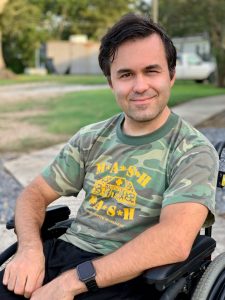Growing Into Life With a Disability

I opened the door to my closet yesterday morning to pick out my shirt for the day. Most of my shirts are solid earth tones, showcasing how boring I am.
As I scanned the hanging T-shirts, my eyes lingered on one. This particular shirt always seems to jump out at me, which is ironic, considering it is camouflage. It reads “M*A*S*H Bash” and was given to me long ago when it enveloped my tiny body like a blanket. Because it’s been through the washing machine so many times, the shirt is soft and comforting.
I took it out of my closet and put it on. It fits now — I just had to grow into it.
***
Being underneath a huge tent with over 100 people didn’t make this summer day in 1997 any cooler.
The M*A*S*H Bash was an annual community health event that offered free health checkups to the local population. My Boy Scout troop helped out, directing people to the part of the tent that was testing blood pressure, doing eye exams, or holding an informational talk on quitting smoking.
When the event wrapped up at 5 p.m., the other Scouts and I began to clear out the tent by breaking down folding tables and chairs from empty health exhibits.
Before our parents arrived to drive us home, we were allowed to take free event T-shirts. The sizes weren’t right for us, we were warned, but we had free rein over the leftover shirts.
We weren’t too excited when we heard this news. Most 12-year-olds don’t really appreciate or get excited about leftover shirts. Our squeaky, prepubescent voices changed their tune when we realized the shirts were camouflage. That suddenly made them cool.
My fellow Scouts were lucky enough to find shirts in their sizes. By the time I was allowed to choose from the worn cardboard box, all of the children’s sizes were taken, leaving ones that would laughably envelop my skinny and gawky frame.
Maybe I can sleep in it?
But that thought didn’t help. I was disappointed and jealous that I didn’t get a cool shirt that fit.
When I got home, I didn’t even stuff it in the drawer with my sleep clothes. I just threw it in the back of my bedroom closet and forgot about it.
I had other things on my mind.
***
I was diagnosed with Friedreich’s ataxia (FA) at 11, and I still didn’t know much about it a year later at the time of the M*A*S*H Bash. I could just tell that physical activities were getting harder. In a year, I dropped out of baseball, gymnastics, and soccer. I would have quit the Boy Scouts, too, but my parents encouraged me to stay. (In other words, they wouldn’t allow me to quit.)
I didn’t know what FA even was at the time. All I knew was that the plans I had for my life were being quietly eroded.
I couldn’t accept the future of a disabled person, so I hid from the knowledge of FA.
The thought of someone using a wheelchair and accepting his or her fate was unspeakably sad to me. Happiness ends when a person needs a wheelchair, I assumed. The sense of loss I felt when quitting soccer and baseball would only get worse when I required a wheelchair.
I didn’t want to be a part of the pitiful narrative.
At least with my huge camouflage shirt, I could blend into the background.
No one would notice me.
Right?
***
Yesterday, I slipped the camouflage shirt over my head. I leaned onto the backrest of my wheelchair and gripped its wheel plates.
I smiled.
It took a while for me to fit snugly in this shirt.
It took a while for me to be happy using a wheelchair.
But I grew into it.
***
Friedreich’s Ataxia News is strictly a news and information website about the disease. It does not provide medical advice, diagnosis or treatment. This content is not intended to be a substitute for professional medical advice, diagnosis, or treatment. Always seek the advice of your physician or another qualified health provider with any questions you may have regarding a medical condition. Never disregard professional medical advice or delay in seeking it because of something you have read on this website.The opinions expressed in this column are not those of Friedreich’s Ataxia News or its parent company, Bionews, and are intended to spark discussion about issues pertaining to Friedreich’s ataxia.








Leave a comment
Fill in the required fields to post. Your email address will not be published.